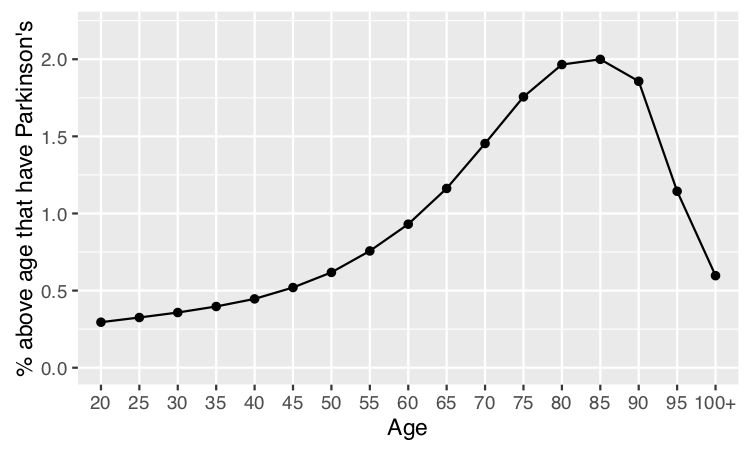Prevalence and Incidence of Parkinson's in New Zealand
The ageing population means that more people are likely to be afflicted with age-related neurodegenerative diseases such as Parkinson’s and Alzheimer’s. Medicine has made huge strides in the last few decades in treating and preventing cardiac issues. With our resulting longer lives, concerns about our brain wearing out are beginning to replace fears of our heart stopping.
We have performed research into the numbers of people in New Zealand with Parkinson’s for the period 2006 to 2024. This study was conducted by Drs Toni Pitcher and Daniel Myall using pharmacoepidemiology methods (identifying cases primarily from medication prescriptions). Citations for the scientific publications of the research are listed at the bottom of the page as well as a link to github where the analysis code can be found.
Number of people with Parkinson's
The number of people with Parkinson's in New Zealand has been steadily increasing, from an estimated 7,000 in 2006, to 11,000 in 2018, 13,000 in 2023, to 14,000 in 2025 (Figure 1). We project that the number of people in New Zealand with Parkinson’s is expected to reach 20,000 by 2040. This is due to the ageing population, which puts more people into the highest risk age groups (>60 years), and also due to people now living longer with the disease.

Figure 1: Number of people in New Zealand that have Parkinson's.
Prevalence and incidence
The proportion of people in a population with a disease is known as the prevalence. In 2013, the prevalence of Parkinson's in New Zealand was 210 cases per 100,000 people. This can also be expressed as ~1 in 500 people or ~0.2% of the total population. Those numbers might seem small, but Parkinson's primarily affects older people: 1% of people over the age of 60, and 2% over the age of 80, have Parkinson’s (Figure 2).
The rate of new cases per year is known as the incidence. The 2013 incidence was 31 new cases per 100,000 people per year. That is, ~1 out of every 3000 people per year are diagnosed with Parkinson’s, but again, the rates are much higher in the older parts of the population.
We found the mean age of onset (using the proxy age of when starting medication) of Parkinson's in New Zealand was 76 years old.

Figure 2: Percentage of population above each age that has Parkinson's
Ethnic Variation
The prevalence and incidence of Parkinson's varies across the major ethnic groups represented in the New Zealand population. Pākehā/NZ Europeans have the highest numbers (a 2013 age-standardised prevalence of 223 cases per 100,000 people in the population) followed by the Asian (174), Pasifika (160), and Māori (114) groups. There are a number of hypotheses that could expain these differences, and we are currently testing them in our ongoing research.
Current Focus
We are investigating the genetic, environmental exposures, and other lifestyle factors associated with Parkinson’s disease, particularly within a New Zealand context. We have a page dedicated to this along with details on how to participate.
We are currently integrating new data sources into our analysis, to better understand risk factors and the geographical and ethnic variation in the prevalence and incidence of Parkinson's in New Zealand.
We are looking at how a range of commonly prescribed drugs may alter the risk of developing and the progression Parkinson's. This may help with understanding aspects of Parkinson's and also guide pathways for development of preventative treatments.
We are looking at the number of people that have Parkinson's with dementia in New Zealand, and the lifetime risk of dementia in Parkinson's. We are also exploring the causes of mortality in people who have Parkinson's, and how Parkinson's influences life expectancy.
Methodology
Media coverage
Research reveals rapid rise of Parkinson’s disease in New Zealand
Radio NZ - Looking at environmental factors in Parkinson's disease onset
Radio NZ - NZ Brain Institute on Parkinson's research advances
TVNZ One News - Parkinsons sufferers to double over the next 20 years
Radio NZ - Call to ensure support for rising Parkinson's sufferers
MedicalXpress - Study predicts future burden of Parkinson's disease in New Zealand
XINHUANET - New Zealand Parkinson's patients to double by 2035
University of Otago - Study predicts future burden of Parkinson’s disease in New Zealand
Collaborations
We are part of the International Parkinson and Movement Disorder Society Epidemiology Study Group.
Further information
Le Heron, C., MacAskill, M.R., Mason, D., Dalrymple-Alford, J., Anderson, T.J., Pitcher, T., Myall, D.J. (2021). A multi-step model of Parkinson’s disease pathogenesis. Movement Disorders, 36, 2530-2538. 10.1002/mds.28719 Open Access Download Voted by the Associate Editors and Editorial Board of Movement Disorders as the best research article published in Movement Disorders in 2021-22
MacAskill, M. R., Myall, D. J., Shoorangiz, R., Anderson, T. J., Pitcher, T. L. (2020). Childbirth and delayed Parkinson’s onset: a reproducible non-biological artefact of societal change. Movement Disorders, 35, 1268-1271. 10.1002/mds.28135 Request pdf
Alamri, Y., Pitcher, T. L., Anderson, T. J. (2020). Variations in the patterns of prevalence and therapy in Australasian Parkinson’s disease patients of different ethnicities. BMJ Neurology Open, 2(1), e000033. 10.1136/bmjno-2019-000033 Open Access Download
Pitcher TL, Myall DJ, Pearson JF, Lacey CJ, Dalrymple-Alford JC, Anderson TJ, MacAskill MR. (2018). Parkinson’s disease across ethnicities: a nationwide study in New Zealand. Movement Disorders,33(9):1440-1448. doi: 10.1002/mds.27389 Request PDF
Myall DJ, Pitcher TL, Pearson JF, Dalrymple-Alford JC, Anderson TJ, MacAskill MR. Parkinson's in the oldest old: Impact on estimates of future disease burden. Parkinsonism & Related Disorders. 2017 42:78-84. doi: 10.1016/j.parkreldis.2017.06.018. Request PDF
Schluter, P. J., Ahuriri-Driscoll, A., Anderson, T. J., Beere, P., Brown, J., Dalrymple-Alford, J., David, T., Davidson, A., Gillon, D. A., Hirdes, J., Keeling, S., Kingham, S., Lacey, C., Menclova, A. K., Millar, N., Mor, V., Jamieson, H. A.(2016).Comprehensive clinical assessment of home-based older persons within New Zealand: an epidemiological profile of a national cross-section.Australian and New Zealand Journal of Public Health. 10.1111/1753-6405.12525 Request pdf
Pitcher, T. L., MacAskill, M. R., Anderson, T. J.(2014).Trends in antiparkinsonian medication use in New Zealand: 1995-2011.Parkinson’s Disease,2014 (379431),1-9. 10.1155/2014/379431 Open Access Download
NZ Parkinson's epidemiology analysis code (Python, R, and Stan) is available at https://github.com/nzbri/pdepi
An illustration of our methodology is available at https://figshare.com/articles/Bayesian_probabilistic_Parkinson_s_epidemiology_model/5400607
Feel free to contact Drs Toni Pitcher or Daniel Myall with any questions you may have.
Acknowledgements
We would like to thank the funders of this research:
We would also like to thank the Ministry of Health National Collections staff for supplying the main datasets used in this research.
We appreciate the excellent work of the Stan development team in creating a powerful platform for full Bayesian statistical inference. Hadley Wickham's ggplot2 and dplyr R packages are also greatly appreciated.
NVIDIA has kindly donated a TITAN V GPU which is being used in this research.




